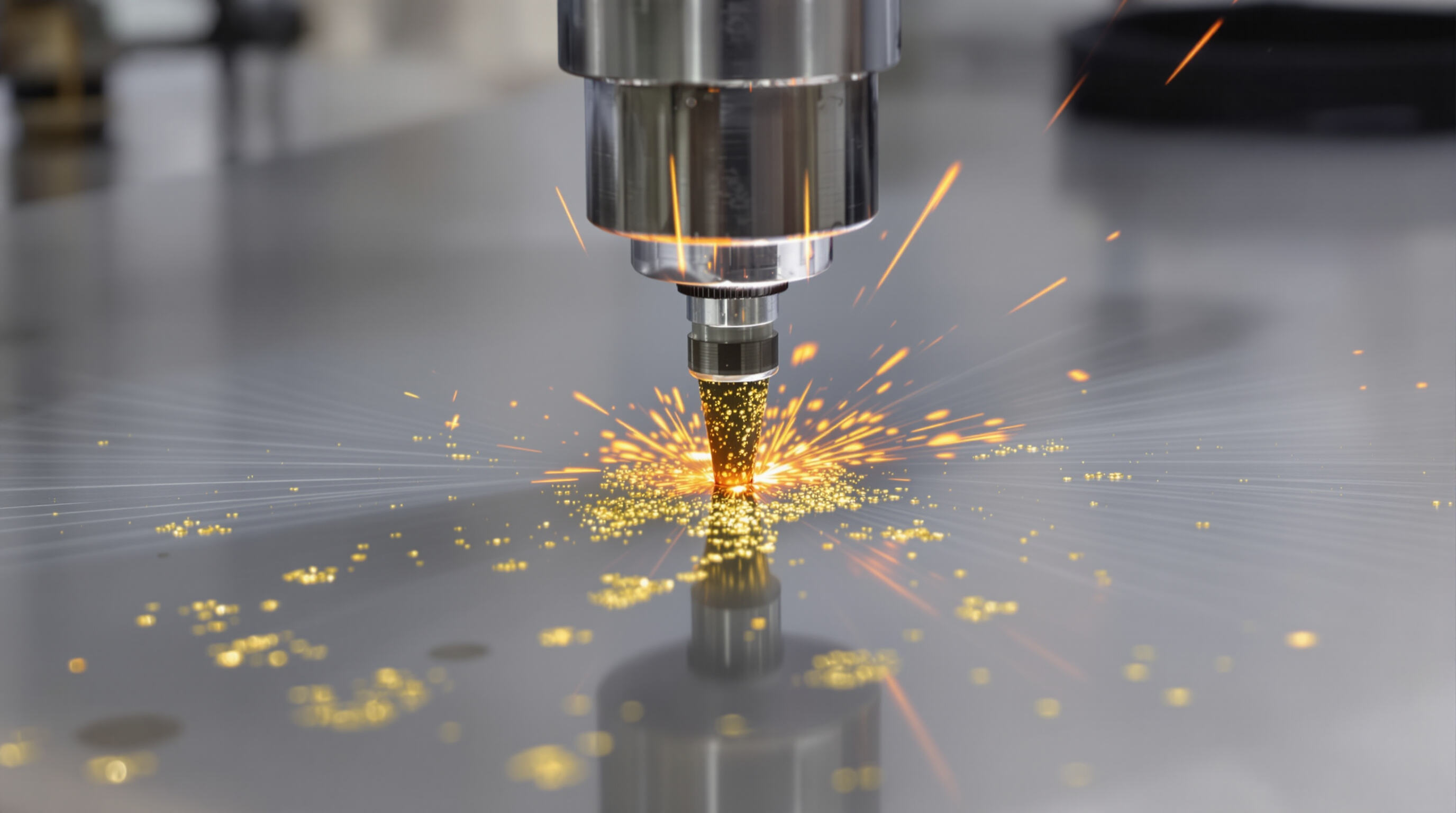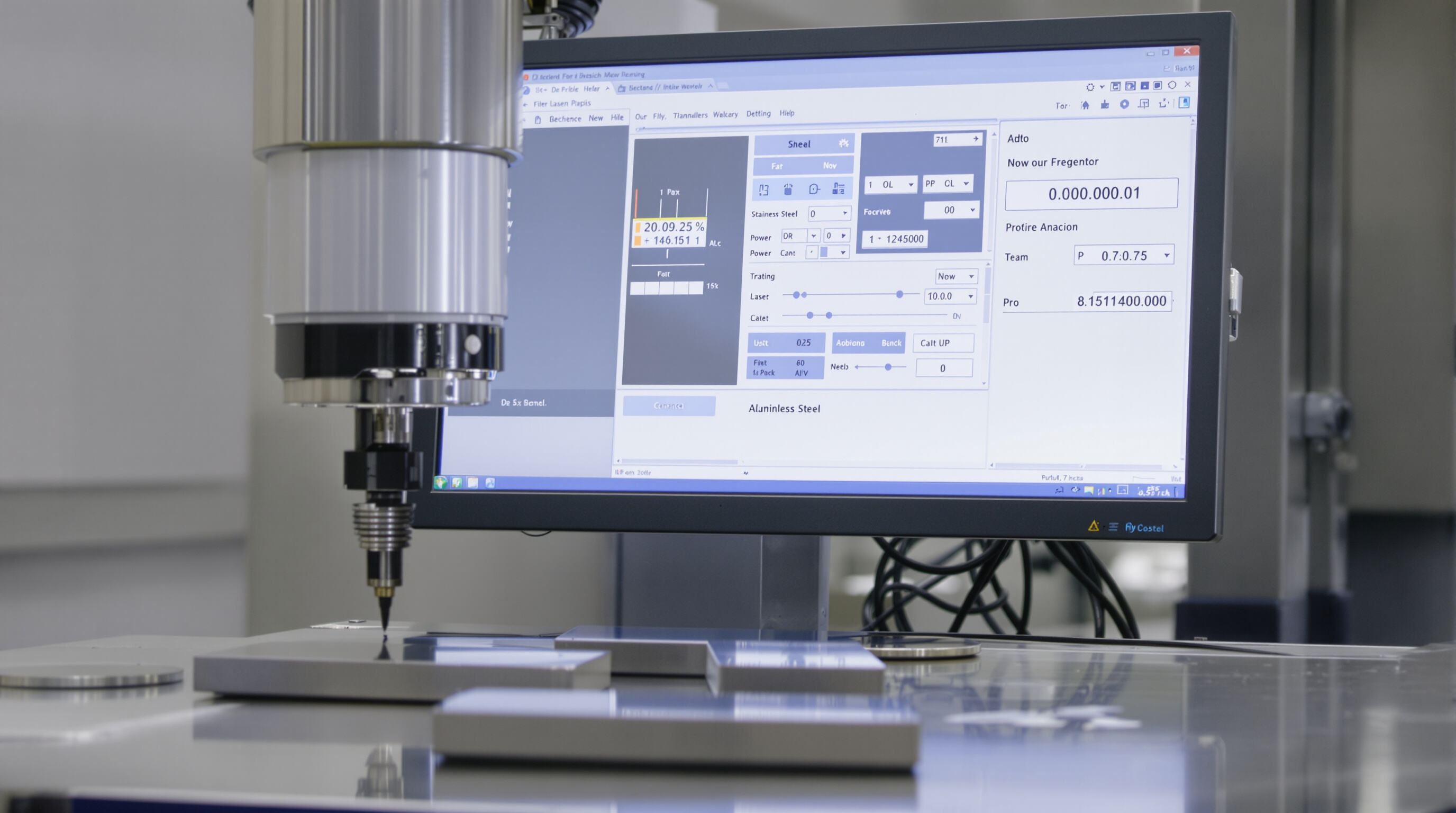The Science Behind Fiber Laser Marking Machines Interaction with Metal Surfaces

The Science Behind How Laser Creates Permanent Marks on Metal Surfaces
Fiber laser marking machines work by making permanent changes to surfaces when metals absorb the machine's 1064 nm wavelength beam. When this intense light hits the material, it actually excites electrons which creates heat spots reaching around 10,000 degrees Celsius according to NMLaser research from 2024. What happens next is pretty interesting - the fast transfer of energy changes how the metal looks at a microscopic level but leaves everything else untouched. This process forms either oxidation layers or tiny cavities on the surface that stand up really well against wear and tear over time.
Process of Laser-Material Interaction: Oxidation, Melting, and Vaporization
During marking, metal surfaces undergo three sequential thermal transformations:
- Oxidation: Surface atoms react with atmospheric oxygen, producing dark, durable oxide layers.
- Melting: Controlled exposure melts shallow layers (0.01–0.5 mm depth), ideal for etching and foaming effects.
- Vaporization: Intense pulses instantly boil material away, enabling deep engraving.
This controlled thermal cascade ensures marks endure harsh industrial cleaning processes such as acid baths and abrasive blasting.
Role of High-Intensity Fiber Laser Beams in Surface Modification
Modern fiber lasers deliver 3–5× higher beam density than CO2 systems, concentrating up to 1 MW/cm² into spots as small as 20 microns. This precision enables two key non-ablative effects:
- Annealing: Heat-induced growth of oxide layers creates high-contrast, corrosion-resistant marks.
- Foaming: Trapped gas bubbles in molten zones increase light scattering for visible contrast on dark metals.
These mechanisms allow structural integrity to be maintained while achieving permanent identification.
Ablation vs. Annealing: Understanding Marking Mechanisms on Metals
- Ablation: Removes 10–200 µm of material through vaporization, ideal for engraved serial numbers on aluminum and steel.
- Annealing: Applies controlled heat below melting point to produce colored oxide layers, commonly used for surgical tools where surface strength must be preserved.
Both methods yield durable results, with permanence validated through ASTM B117 salt spray tests showing less than 5% visibility loss after 500+ hours.
Core Technology of Fiber Laser Marking Machines for Metals
How Fiber Laser Engravers Work: Core Components and Beam Delivery
The heart of fiber laser marking machines lies in three main parts: first, there's the actual laser source itself. Then comes the ytterbium-doped fiber optic resonator where most of the magic happens. And finally, we have the galvanometer system that handles beam delivery. When laser diodes kick things off, they create light that gets boosted inside those doped fibers, resulting in a pretty focused 1064 nm beam. What makes these systems so effective is how accurately they can direct this beam using scanning mirrors capable of hitting targets within just 5 to 10 micrometers on metal surfaces. Since this whole process doesn't involve physical contact with materials being marked, there's no tool wear to worry about. Plus, these machines operate at around 28% electro-optical efficiency which beats traditional CO2 lasers by about threefold according to recent research published in the Journal of Photonics last year.
Precision and Beam Quality of Fiber Lasers in Metal Processing
Fiber lasers that maintain an M squared value below 1.1 can mark incredibly small details as tiny as 0.005 mm, which is really important for things like numbering parts used in aircraft and creating those unique device identifiers needed for medical equipment. When using pulsed fiber lasers, operators have the ability to adjust frequencies between 1 and 200 kHz, giving them much better control over how energy gets deposited onto materials. This results in consistent marking depths within about plus or minus 0.002 mm on stainless steel surfaces. What makes these newer technologies stand out is their ability to cut down heat affected areas by around 40 percent when compared to older systems, all while keeping contrast levels pretty uniform at approximately 98.5% even under tough conditions according to research from the Ponemon Institute back in 2023.
Why Fiber Lasers Outperform CO2 and UV Lasers in Metal Marking
Fiber lasers dominate metal marking due to three distinct advantages:
- Material Compatibility: The 1064 nm wavelength achieves ~80% absorption on aluminum and steel, far exceeding the <15% efficiency of CO2 lasers.
- Operational Efficiency: A 70W fiber laser marks metal 2.5× faster than a 100W CO2 system while consuming 30% less power.
- Durability: Fiber laser marks withstand over 500 hours of salt spray testing (ASTM B117), outperforming UV-laser ablation on polymers by a factor of three.
Industry data shows a 23% reduction in total ownership costs when transitioning from lamp-pumped to fiber systems, thanks to diode lifespans exceeding 100,000 hours and no consumables (Manufacturing Trends Report, 2024).
Laser Marking vs. Engraving: Techniques for Permanent Metal Identification
Defining Laser Marking, Engraving, and Etching on Metal Surfaces
Fiber laser systems utilize three primary techniques for metal identification:
- Laser engraving: Vaporizes material to form recessed grooves (0.02–1 mm deep), best suited for industrial part numbering.
- Laser etching: Melts the surface to create shallow textures (0.002–0.02 mm), often used for logos on stainless steel.
- Laser marking: Alters surface chemistry without removing material, generating high-contrast discolorations ideal for medical instruments.
Depth, Durability, and Application Differences Between Techniques
| Process | Depth Range | Durability | Common Applications |
|---|---|---|---|
| Engraving | 0.02mm – 1mm | Extreme | Tool branding, aerospace components |
| Etching | 0.002mm – 0.02mm | High | QR codes, decorative surfaces |
| Marking | Surface-level | Medium-high | Surgical tools, electronic enclosures |
While engraving offers maximum depth, modern fiber laser marking can produce subsurface oxidation layers that resist chemical exposure better than shallow engravings—particularly in aluminum alloys.
Industry Insight: When 'Marking' Achieves Deeper Permanence Than 'Engraving'
According to research published in 2023 on aerospace materials, laser marks created through annealing lasted almost half a year longer during salt spray tests compared to those made by mechanical engraving methods. The reason? Fiber lasers actually create protective oxide layers under the surface instead of cutting away material like traditional engraving does. For parts inside jet engines, this matters a lot since keeping the surface intact helps avoid those dangerous stress cracks that can develop over time. Many aircraft component makers are now switching to laser marking techniques when working with titanium pieces that need to meet FAA standards for tracking purposes while still maintaining their structural integrity.
Durability and Industrial Applications of Fiber Laser Marks on Metal
Fiber laser marks offer unmatched permanence for industrial metal identification. According to the International Journal of Advanced Manufacturing Technology (2023), these marks retain 99.8% legibility after more than 15 years of continuous industrial use—surpassing traditional methods like inkjet printing and chemical etching.
Long-term performance of permanent marking on metal surfaces
Fiber laser modifications occur at the atomic level, creating stable oxidation layers or micro-textures resistant to abrasion, industrial cleaning, and UV degradation. Their durability is certified under DIN EN ISO 6402-2 standards, confirming long-term reliability in mission-critical applications.
Resistance to environmental stressors: heat, moisture, and chemicals
NASA testing (2022) confirmed fiber laser markings on titanium alloys remained fully readable after:
- 2,000 hours at 650°C
- Salt spray exposure simulating 50 years in coastal conditions
- Immersion in hydraulic fluids and aviation fuels
These results underscore the suitability of fiber laser marks for extreme operational environments.
Case Study: Aerospace component traceability using fiber laser markings
A leading turbine manufacturer improved part tracking by 40% after replacing stamped codes with QR codes marked by a 50W fiber laser. The markings endured over 10,000 thermal cycles in jet engine components and remained scannable with sub-0.1mm precision.
Case Study: High-contrast serial number marking on aluminum enclosures
By optimizing pulse frequency to 120 kHz and using assist gases, an electronics producer achieved crisp white marks on anodized aluminum. These markings passed IPC-650 adhesion tests and remained intact after:
- Over 500 wipe-downs with industrial solvents
- 10-year outdoor exposure trials
- Electromagnetic interference testing up to 100 GHz
Optimizing Laser Parameters for Different Metals and Future Trends

How Power Settings Influence Depth and Contrast in Fiber Laser Engraving on Metal
Laser power directly affects mark depth and visibility. On stainless steel, higher power (20–50 W) induces deeper ablation and controlled oxidation for high-contrast results. For aluminum, lower power (5–15 W) prevents warping while enabling legible annealing marks that preserve surface integrity.
Optimizing Pulse Frequency and Marking Speed for Different Metals
| Metal | Optimal Frequency (kHz) | Speed (mm/s) |
|---|---|---|
| Stainless Steel | 20–50 | 800–1,200 |
| Aluminum | 30–80 | 1,500–2,000 |
Higher frequencies prevent overheating in thermally conductive materials like aluminum, while slower speeds ensure sufficient energy buildup for effective oxidation in stainless steel.
Parameter Benchmarks for Stainless Steel and Aluminum Marking
Stainless steel typically requires 30W power with 80% hatch overlap to produce corrosion-resistant serial numbers. In contrast, aluminum achieves FDA-compliant markings at 10W with 120% scan spacing, minimizing thermal distortion.
AI-Driven Parameter Optimization in Modern Laser Marking Machines
Machine learning algorithms now predict optimal settings 34% faster than manual configuration (LaserTech Journal, 2024). Integrated vision systems analyze material composition and surface finish in real time, automatically adjusting parameters for consistent mark quality across variable production batches.
Future Strategy: Expanding Applications in Automotive and Medical Device Manufacturing
Automotive manufacturers are adopting fiber lasers for VIN marking on engine blocks, leveraging their permanence and resistance to extreme conditions. In the medical sector, sub-micron precision enables durable identifiers on surgical tools that survive repeated autoclave cycles, supporting regulatory compliance and patient safety.
FAQ
What makes fiber lasers suitable for metal marking?
Fiber lasers offer high precision and efficiency with a 1064 nm wavelength that is well-absorbed by metals like aluminum and steel, resulting in strong and durable marks.
How do fiber laser marks compare in terms of durability?
Fiber laser marks are known for their durability, maintaining 99.8% legibility even after 15+ years in industrial use. Marks are resistant to wear and environmental stressors such as heat, moisture, and chemicals.
What are the key differences between laser marking, engraving, and etching?
Laser engraving involves vaporizing material to form grooves, etching melts the surface for shallow textures, while marking alters surface chemistry without removing material for high-contrast discolorations.
Why do industries prefer fiber lasers over CO2 and UV lasers?
Fiber lasers are favored due to better material compatibility, operational efficiency, and the durability of marks, which outperform CO2 and UV laser solutions in many applications.
How does AI contribute to laser marking efficiency?
AI-driven systems optimize laser parameters faster than manual configurations, enhancing precision and consistency in marking processes across various materials and conditions.
Table of Contents
- The Science Behind Fiber Laser Marking Machines Interaction with Metal Surfaces
- Core Technology of Fiber Laser Marking Machines for Metals
- Laser Marking vs. Engraving: Techniques for Permanent Metal Identification
- Defining Laser Marking, Engraving, and Etching on Metal Surfaces
- Depth, Durability, and Application Differences Between Techniques
- Industry Insight: When 'Marking' Achieves Deeper Permanence Than 'Engraving'
- Durability and Industrial Applications of Fiber Laser Marks on Metal
-
Optimizing Laser Parameters for Different Metals and Future Trends
- How Power Settings Influence Depth and Contrast in Fiber Laser Engraving on Metal
- Optimizing Pulse Frequency and Marking Speed for Different Metals
- Parameter Benchmarks for Stainless Steel and Aluminum Marking
- AI-Driven Parameter Optimization in Modern Laser Marking Machines
- Future Strategy: Expanding Applications in Automotive and Medical Device Manufacturing
- FAQ

